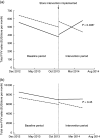Choice architecture to promote fruit and vegetable purchases by families participating in the Special Supplemental Program for Women, Infants, and Children (WIC): randomized corner store pilot study
- PMID: 27890020
- PMCID: PMC5407909
- DOI: 10.1017/S1368980016003074
Choice architecture to promote fruit and vegetable purchases by families participating in the Special Supplemental Program for Women, Infants, and Children (WIC): randomized corner store pilot study
Abstract
Objective: To conduct a pilot study to determine if improving the visibility and quality of fresh produce (choice architecture) in corner stores would increase fruit/vegetable purchases by families participating in the Special Supplemental Nutrition Program for Women, Infants, and Children (WIC).
Design: Six stores were randomly assigned to choice architecture intervention or control. Store-level WIC sales data were provided by the state. Primary outcomes were WIC fruit/vegetable voucher and non-fruit/vegetable voucher sales, comparing trends from baseline (December 2012-October 2013) with the five-month intervention period (December 2013-April 2014). Secondary outcomes were differences in customer self-reported fruit/vegetable purchases between baseline and end of the intervention.
Setting: Chelsea, MA, USA, a low-income urban community.
Subjects: Adult customers (n 575) completing store exit interviews.
Results: During baseline, WIC fruit/vegetable and non-fruit/vegetable sales decreased in both intervention and control stores by $US 16/month. During the intervention period, WIC fruit/vegetable sales increased in intervention stores by $US 40/month but decreased in control stores by $US 23/month (difference in trends: $US 63/month; 95 % CI 4, 121 $US/month; P=0·036); WIC non-fruit/vegetable sales were not different (P=0·45). Comparing baseline and intervention-period exit interview responses by customers participating in WIC (n 134), intervention store customers reported increased fruit/vegetable purchases compared with control store customers (18 v. -2 %), but this did not achieve statistical significance (P=0·11).
Conclusions: Placement of fruits/vegetables near the front of corner stores increased purchase of produce by customers using WIC. New policies that incentivize stores to stock and prominently display good-quality produce could promote healthier food choices of low-income families.
Keywords: Choice architecture; Corner stores; Fruits and vegetables; WIC.
Figures

References
-
- Swinburn BA, Sacks G, Hall KD et al.. (2011) The global obesity pandemic: shaped by global drivers and local environments. Lancet 378, 804–814. - PubMed
-
- Keener D, Goodman K, Lowry A et al.. (2009) Recommended Community Strategies and Measurements to Prevent Obesity in the United States: Implementation and Measurement Guide. Atlanta, GA: US Department of Health and Human Services, Centers for Disease Control and Prevention.
-
- Inagami S, Cohen DA, Finch BK et al.. (2006) You are where you shop: grocery store locations, weight, and neighborhoods. Am J Prev Med 31, 10–17. - PubMed
-
- Morland K, Diez Roux AV & Wing S (2006) Supermarkets, other food stores, and obesity: the Atherosclerosis Risk in Communities Study. Am J Prev Med 30, 333–339. - PubMed
Publication types
MeSH terms
Grants and funding
LinkOut - more resources
Full Text Sources
Other Literature Sources
Miscellaneous

